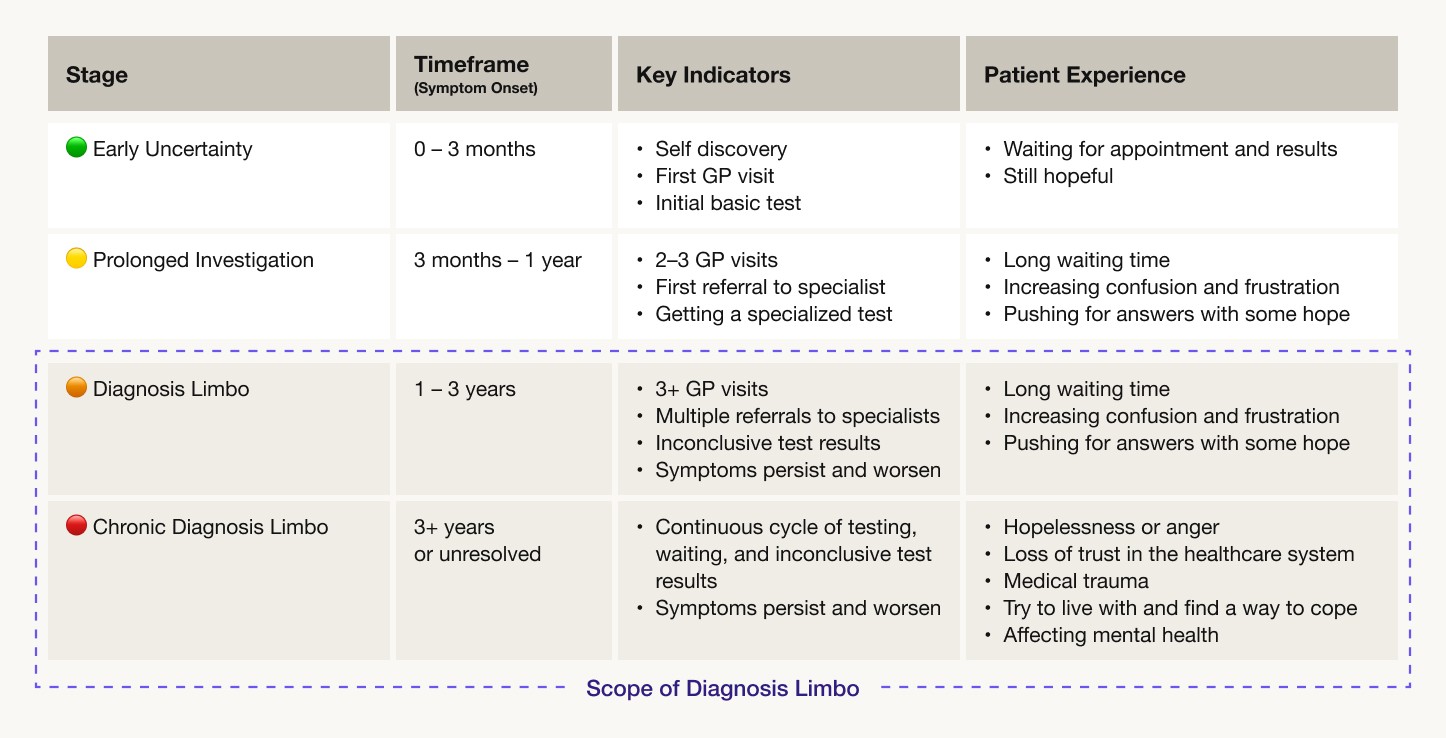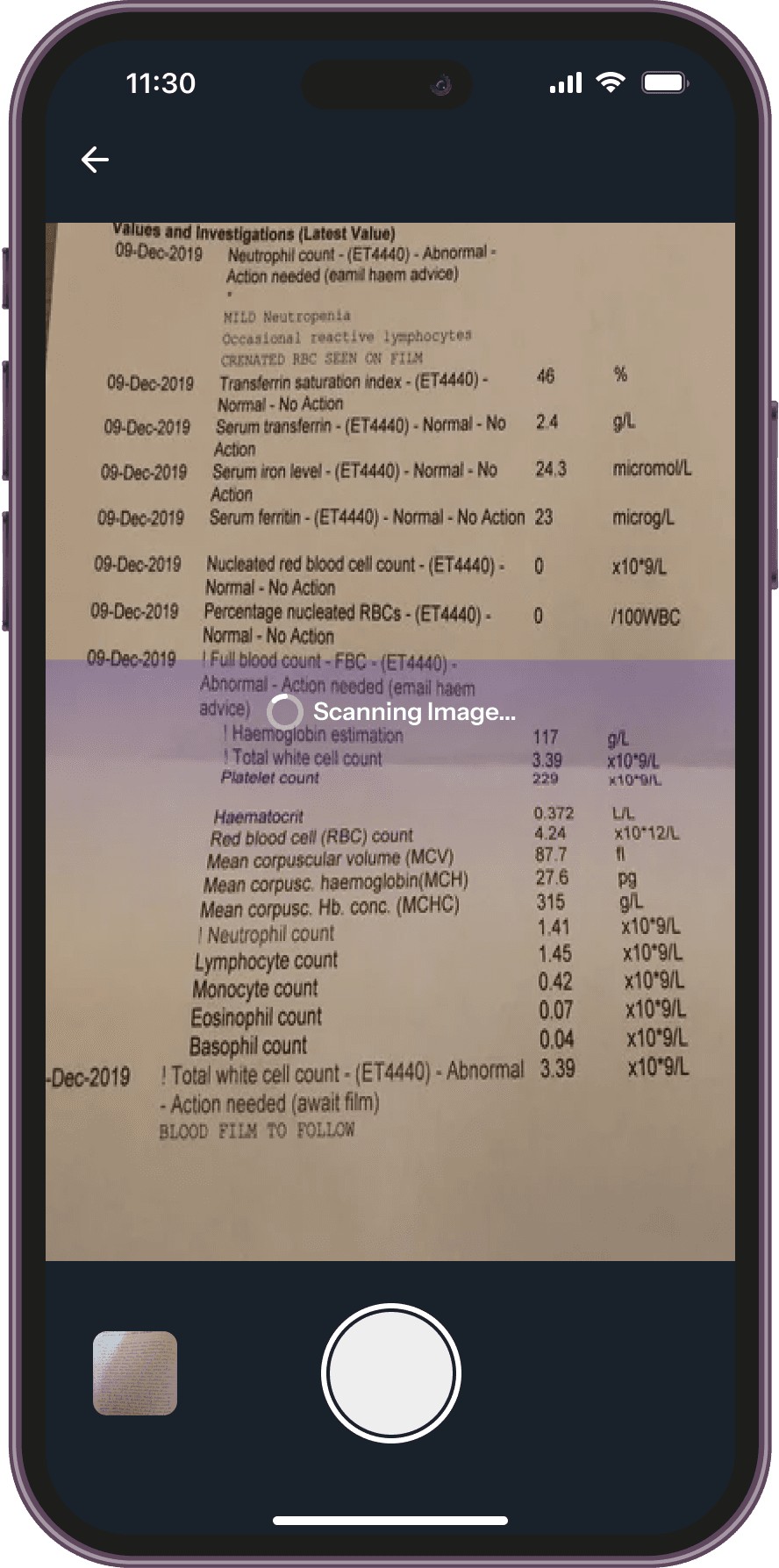problem SPace
Diagnosis Limbo is a prolonged period of uncertainty when someone has symptoms but no clear diagnosis
An estimated 5.7 million women in the UK are currently awaiting a diagnosis for a range of health conditions. Nearly 1 in 3 (30%) are experiencing symptoms related to women’s health issues—such as PCOS, endometriosis, or gynaecological cancers—yet have not received a formal diagnosis.
On average, the diagnostic journey for a women’s health condition takes 2 years 3 months, with conditions like endometriosis taking up to 8 years to be properly diagnosed.
What does it feel like to live in uncertainty, to wait for answers that might never come?
We conducted in-depth interviews with total of 20 participants—13 Patients and 7 Healthcare Practitioners (HCPs) to deepened and enriched our understanding about the issues.
Patient’s Journey Map
This Patient’s Journey Map provides valuable insight into the challenges a patient faces when they are experiencing diagnosis limbo.
Stages of Diagnostic Journey
Defined stages to understand the scope of Diagnosis Limbo.
Interview INsights
Patient’s Challenges
Patients feel marginalised and alone
Despite how common this experience is, every interviewee described feeling isolated in their journey — especially when their condition lacked a clear name or diagnosis.
Communication is frustrating
Patients often feel dismissed or gaslit by medical professionals, while also struggling to piece together or recall patterns in their own symptoms and experiences.
Failed by the healthcare system
Systemic failures make the journey feel endless and disheartening. Many patients expressed a desire to regain control, often resorting to self-advocacy and independent research to find answers.
Patient’s Empathy Map synthesized from the patient interviews.
Healthcare Practitioners’(HCPs) Challenges
HCPs must run a tight schedule
Most GP visits last 15–20 minutes, with HCPs juggling patient care and admin. There is a high demand for appointments, but a limited capacity to deliver them, leading to rushed consultations and patient dissatisfaction.
Rise of self-diagnosis
Patients often turn to the internet for answers. While it can empower them, it also risks misinformation and anxiety, sometimes complicating appointments or delaying proper treatment.
HCPs may react to patients’ emotions in differently
Patients often arrive feeling emotional or frustrated. Some HCPs may take this personally, while others feel sympathy and try to offer extra support. Since patients rarely see the same doctor, reactions vary, making the doctor-patient relationship feel unpredictable.
PRoblem Mapping
To synthesize our research findings, we gathered and grouped all the problems we found, then mapped how they connect within the healthcare system. We categorized and organized problems based on their scale of control:
Personal-level Problems
Advocacy Behaviour
Patient advocacy varies based on how individuals navigate diagnosis limbo.
Negative Emotions
Patients in diagnosis limbo often face overwhelming negative emotions.
Community & Biases
Many patients in diagnosis limbo feel isolated as they struggle to find relatable supports.
System-level Problems
Medical Administration
Current administration is inefficient and frustrating. Long wait times and difficulty booking appointments make navigating the system stressful.
Doctor-Patient Relationship
Doctors often fail to provide emotional support due to the lack of a personal relationship between doctor and patient.
Fragmented Data & Poor UX
Fragmented medical data, lacking accessibility and transparency, forces patients to repeatedly explain their history to different doctors.
Healthcare Cost Burden
Diagnosis limbo burdens the healthcare system, with delays leading to inefficiencies and economic losses.
Medical Literacy & Education
Many struggle to understand what is normal or concerning, especially when medical information is complex and often inaccessible.
Gender Inequality in Healthcare
Women’s health often ignored or stigmatized in both society and medical research, which leads to a gender data gap in the system.
Design Opportunity
How might we empower women in the UK who are experiencing the challenges of Diagnosis Limbo feel seen, heard, and supported through the journey—so they can reclaim trust in their bodies, voices, and the care they deserve?
A patient’s mindset is a key factor in navigating the uncertainty of diagnosis limbo, especially when external systems fall short in providing support. Developing the right mindset can empower patients to take an active role in managing their health, even in the face of ambiguity.
Key factors such as outlook, disposition, emotional regulation, cognitive state, health literacy, sense of agency, system dependence, and social context all influence how patients cope with this challenging period. This shift in mindset and behavior can support clearer communication, more effective self-advocacy, and ultimately, improved diagnostic and patient’s health outcomes.
Cultivating the Ideal Patient Mindset. Key behavioral traits for navigating the uncertainty of diagnosis limbo.
Designing Guiding Principles
Empower Personal Agency
Create tools that enable individuals to control how they track and share their symptoms and experiences—putting them at the center of their health journey.
Clarity Through Education
Deliver accessible and personalised information that helps users understand their symptoms, navigate medical jargon, and determine appropriate next steps.
Confidence in Storytelling
Support users in effectively articulating their health narratives, ensuring they feel heard and respected in clinical interactions.
Emotional Safety & Community Connection
Design with empathy by offering peer stories, expert guidance, and emotional support to reduce isolation and anxiety.
Privacy & Trust
Protect sensitive health data with secure systems and transparent practices, building trust and ensuring user safety at every touchpoint.
Feature 1.1
Track symptoms in various ways
DiaLog empowers patients to track their symptoms in various ways. through voice notes, photos, journal entries, or by scanning images. A guided template further supports patients in easily logging symptoms and other relevant health information.
Feature 1.2
One place for patients’ entire health story
By consolidating medical records, symptom logs, doctor notes, appointment schedules, and personal reflections in one secure place, it helps patients and healthcare providers stay aligned, informed, and proactive—making it easier to review past records and maintain continuity of care.
A built-in smart search feature enables quick access to stored health information, while DiaLog prioritizes user trust through transparency, confidentiality, and giving patients full control over their personal data.
Feature 2
Draws curated & actionable insights
DiaLog cuts through the noise and draws out patterns and actionable insights based on patient's health repository, using a smart information tagging system. It also visualises each patient’s medical journey, highlighting key trends and turning points to support better understanding and decision-making.
Feature 3
Guidance on navigating difficult medical conversations
DiaLog provides guidance on navigating difficult medical conversations, from know-how tips, conversation prompts, and preparation guides. Empowering individuals to communicate effectively, ask the right questions, and advocate for themselves throughout their health journey.
With its built-in Chat AI feature, DiaLog helps users prepare for medical visits, ensuring more meaningful consultations and better communication of their health experiences.
Feature 4
Access to trusted medical knowledge & global doctors
DiaLog provides access to a library of vetted clinical studies, research papers, and educational materials tailored to your symptoms and health journey. It also connects patients to verified medical professionals worldwide through telemedicine—offering second opinions and diverse perspectives to help them stay informed, confident, and no longer limited by local healthcare boundaries.
Feature 5
Connect with & contribute to the community
DiaLog connects patients with others experiencing similar symptoms and journeys, fostering a sense of empowerment, validation, understanding, and being truly heard. It nurtures emotional connection by celebrating small milestones, tracking personal growth, and encouraging peer advocacy.
DiaLog’s Service Blueprint
Sustainable Business Model Canvas
“This project took our breath away. DiaLog looks at the problem of diagnosis limbo from multiple angles and provides a number of ways to track, understand, and connect around symptoms. The service is robust and offers a unique and fitting experience for every individual. We commend the team for using both qualitative and quantitative research to design a service with empathy at its core”
—Philips' Statement of the Project
“DiaLog successfully reframes “diagnosis limbo” as a condition worthy of recognition. It stands out as a model for responsible, inclusive service design in healthcare, which redefines a neglected experience, delivers a credible and compassionate solution, and demonstrates the systemic potential of design when it centers human dignity. It bridges the gender health gap with measurable psychological and systemic benefits.”
—Judge's Statement from Service Design Global Conference
“DiaLog will allow patients to feel satisfied in their approach to their illness and help build better interpersonal relationships, which invariably leads to better healthcare.”
—NHS Medical Doctor (MD)
“I would put all my notes and medical references into DiaLog if it existed. It simplifies things a lot.”
—Patient in 4-Year Diagnosis Limbo
























